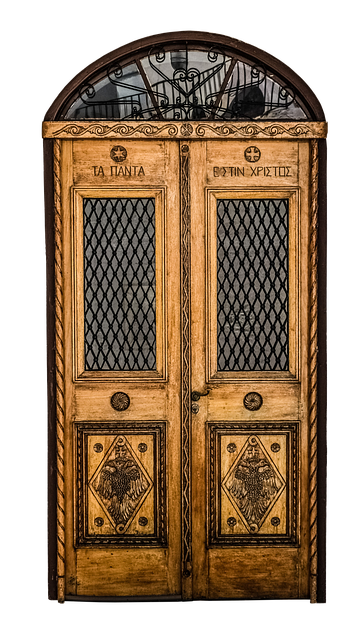Fire safety codes heavily rely on steel entry doors with specific fire ratings to protect buildings and occupants, especially in high-risk areas like entrances and exits. These doors are engineered with heat-resistant materials, tested by reputable organizations (e.g., UL), and maintain structural integrity through reinforced construction. Proper installation, regular maintenance, including cleaning and lubrication, ensure their effectiveness during emergencies. Real-world applications, such as schools and office buildings, have shown significant reductions in smoke spread and safer evacuations thanks to fire-rated steel entry doors.
Fire-rated steel doors are essential components in ensuring building safety and compliance with stringent fire codes. This article delves into the critical role these doors play in protecting against fire hazards, guiding readers through understanding relevant standards, their construction benefits, and key features to consider. We explore real-world applications, offering valuable insights for optimal installation, maintenance, and successful implementations of steel entry doors.
Understanding Fire Safety Codes and Standards for Steel Entry Doors
Fire safety codes and standards are crucial in ensuring the protection of buildings and their occupants from fire hazards, especially for critical areas like exits and entrances. When it comes to steel entry doors, understanding these regulations is paramount. Many regions have specific requirements for fire-rated steel doors to meet or exceed local building codes, ensuring they can withstand fire conditions for a specified period, providing vital escape routes and containing the spread of flames.
These standards often dictate factors such as door construction, materials used, insulation properties, and testing procedures. For example, steel entry doors may need to be fitted with specific fire-resistant seals, glass with heat-strengthened or laminated properties, and mechanical hardware designed to prevent failure during a fire event. By adhering to these codes, building owners and architects can ensure the safety of occupants and compliance with regulations, making steel entry doors a vital component in any fire safety strategy.
The Role of Fire-Rated Steel Doors in Building Construction
Fire-rated steel doors play a pivotal role in modern building construction, serving as a critical line of defense against the devastating effects of fire. These robust doors are designed to withstand extreme temperatures and provide insulation from the heat and smoke that can be life-threatening. In commercial and residential buildings alike, steel entry doors with fire ratings offer essential protection for occupants and property.
The incorporation of fire-rated steel doors is mandated by safety codes and regulations worldwide, ensuring that structures meet minimum standards for fire resilience. These doors are engineered to delay the spread of fire, providing valuable time for people to evacuate safely. Their construction involves specialized materials and techniques, guaranteeing a robust barrier that can resist the force of flames and prevent the rapid transmission of fire from one area to another.
Key Features and Certifications of High-Quality Fire Doors
High-quality fire doors are a critical component in ensuring building safety and compliance with fire codes. Key features distinguish these doors from standard steel entry doors, making them effective barriers against fire hazards. Look for doors that incorporate an integer fire rating, indicating their resistance to heat transfer, typically measured in minutes. This rating ensures that the door can withstand exposure to fire without failing, providing valuable time for evacuation.
Certifications from reputable organizations like Underwriters Laboratories (UL) or Intertek confirm the fire protection capabilities of these doors. These certifications subject fire doors to rigorous testing, ensuring they meet strict performance standards. Additionally, high-quality steel entry doors often feature reinforced construction with robust hinges and closures, enhancing structural integrity during a fire. Look for doors with sealed edges and continuous welds, preventing heat from penetrating at vulnerable points.
Installation and Maintenance Tips for Optimal Protection
Proper installation and regular maintenance are key to ensuring that fire-rated steel entry doors provide optimal protection against fire hazards. When installing, ensure all hinges, latches, and bolts are securely fastened according to the manufacturer’s instructions. Check for proper alignment and adjust if needed. Regular cleaning and inspection of these doors are crucial; dust, dirt, or debris can compromise their seal and integrity over time. Look for signs of wear and tear, such as damaged seals or loose components, and replace any worn parts promptly.
Additionally, maintain a clear space around the door frame to allow for proper thermal expansion and contraction. Keep the area free from obstructions that could impede the door’s opening or closing. Regular lubrication of hinges can also prevent excessive friction and ensure smooth operation during an emergency exit. Remember, even with high-quality fire-rated steel entry doors, consistent care and attention are necessary to guarantee their longevity and effectiveness in case of a fire.
Real-World Applications: Case Studies of Successful Fire Door Implementations
In real-world applications, fire-rated steel entry doors have proven their worth in numerous successful case studies. Schools, hospitals, office buildings, and high-rise apartments have all benefited from implementing these safety measures. For instance, a recent study highlighted how fire-rated doors in a major metropolitan school district significantly reduced the spread of smoke and fire during emergency evacuations, ensuring the safe exit of thousands of students and staff.
Another compelling case involves a historic downtown business district where older wooden doors were replaced with high-quality steel ones. This upgrade not only enhanced the aesthetics but also provided superior protection against fire hazards, as seen in several incidents where nearby buildings suffered extensive damage due to fire spread. These examples underscore the critical role of fire-rated steel entry doors in safeguarding lives and property.
Fire-rated steel entry doors are a vital component in ensuring building safety and compliance with stringent fire safety codes. By understanding the role of these doors, their key features, and proper installation practices, architects, builders, and property managers can effectively protect buildings and occupants from devastating fire hazards. High-quality fire doors, backed by relevant certifications, offer robust protection, contributing to a safer built environment.
